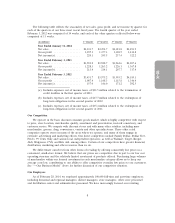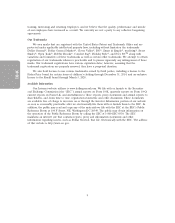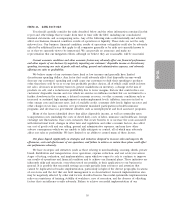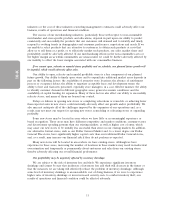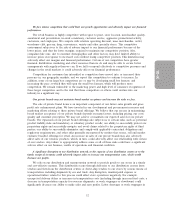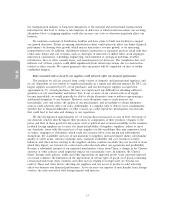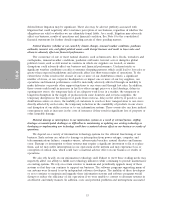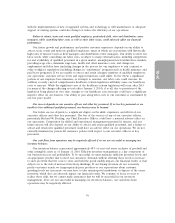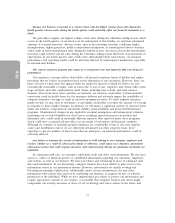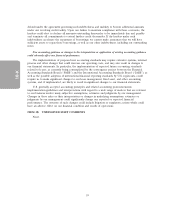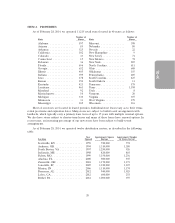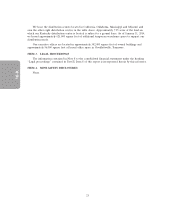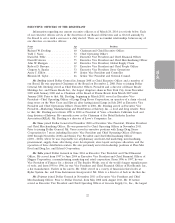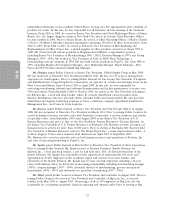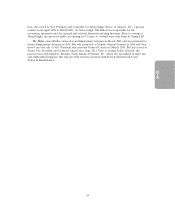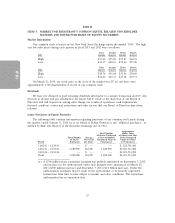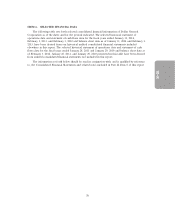Dollar General 2013 Annual Report Download - page 93
Download and view the complete annual report
Please find page 93 of the 2013 Dollar General annual report below. You can navigate through the pages in the report by either clicking on the pages listed below, or by using the keyword search tool below to find specific information within the annual report.
with the implementation of new or upgraded systems and technology or with maintenance or adequate
support of existing systems could also disrupt or reduce the efficiency of our operations.
Failure to attract, train and retain qualified employees, particularly field, store and distribution center
managers, while controlling labor costs, as well as other labor issues, could adversely affect our financial
performance.
Our future growth and performance and positive customer experience depends on our ability to
attract, train, retain and motivate qualified employees, many of whom are in positions with historically
high rates of turnover such as field managers and distribution center managers. Our ability to meet our
labor needs, while controlling our labor costs, is subject to many external factors, including competition
for and availability of qualified personnel in a given market, unemployment levels within those markets,
prevailing wage rates, minimum wage laws, health and other insurance costs, and changes in
employment and labor laws (including changes in the process for our employees to join a union) or
other workplace regulations (including changes in ‘‘entitlement’’ programs such as health insurance and
paid leave programs). If we are unable to attract and retain adequate numbers of qualified employees,
our operations, customer service levels and support functions could suffer. To the extent a significant
portion of our employee base unionizes, or attempts to unionize, our labor costs could increase. In
addition, recently enacted comprehensive healthcare reform legislation will likely cause our healthcare
costs to increase. While the significant costs of the healthcare reform legislation will occur after 2013
(as many of the changes affecting us took effect January 1, 2014), if at all, due to provisions of the
legislation being phased in over time, changes to our healthcare costs structure could have a significant
negative effect on our business. Our ability to pass along labor costs to our customers is constrained by
our low price model.
Our success depends on our executive officers and other key personnel. If we lose key personnel or are
unable to hire additional qualified personnel, our business may be harmed.
Our future success depends to a significant degree on the skills, experience and efforts of our
executive officers and other key personnel. The loss of the services of any of our executive officers,
particularly Richard W. Dreiling, our Chief Executive Officer, could have a material adverse effect on
our operations. Competition for skilled and experienced management personnel is intense, and our
future success will also depend on our ability to attract and retain qualified personnel, and a failure to
attract and retain new qualified personnel could have an adverse effect on our operations. We do not
currently maintain key person life insurance policies with respect to our executive officers or key
personnel.
Our cash flows from operations may be negatively affected if we are not successful in managing our
inventory balances.
Our inventory balance represented approximately 48% of our total assets exclusive of goodwill and
other intangible assets as of January 31, 2014. Efficient inventory management is a key component of
our business success and profitability. To be successful, we must maintain sufficient inventory levels and
an appropriate product mix to meet our customers’ demands without allowing those levels to increase
to such an extent that the costs to store and hold the goods unduly impacts our financial results or that
subjects us to the risk of increased inventory shrinkage. If our buying decisions do not accurately
predict customer trends, we inappropriately price products or our expectations about customer
spending levels are inaccurate, we may have to take unanticipated markdowns to dispose of the excess
inventory, which also can adversely impact our financial results. We continue to focus on ways to
reduce these risks, but we cannot make assurances that we will be successful in our inventory
management. If we are not successful in managing our inventory balances, our cash flows from
operations may be negatively affected.
16
10-K




